Pivot Shuttle LT
Wheel Size: 29’’
Travel: 160 mm rear / 170 mm front
Material: Carbon fiber
Price: Complete bikes: $9,900 – $12,000
Claimed weight: 49.8 lb / 22.5 kg (Shuttle LT Team XTR)

Intro
Not content to take a break after launching the new Shuttle SL just a few weeks ago, Pivot has followed it up with the all-new Shuttle LT. As you’ve probably guessed, “LT” stands for “Long Travel,” and in many ways, the new bike appears to be a lot like an electrified Firebird. But it’s not just that, so let’s dig in.
[The longstanding Shuttle also sticks around in Pivot’s lineup, with a rebrand to “Shuttle AM” to slot in between the two new bikes.]
The Frame
A lot of the main points here aren’t going to be much of a surprise to folks who are familiar with Pivot — the Shuttle LT gets 160 mm of DW-link rear suspension, built around the vertically-oriented shock layout that Pivot has been migrating their lineup to for a few years now. The Shuttle LT is offered in carbon fiber only, the rear triangle uses 157 mm SuperBoost spacing, the cable routing is internal, and there’s a geometry adjusting flip-chip in the rocker link pivot. There’s also room for a full-size water bottle inside the front triangle on the entire size range, plus an accessory mount under the top tube, and ample rubber guards on the chainstay, seatstay, and rear triangle — all the stuff we’ve come to expect from Pivot these days.
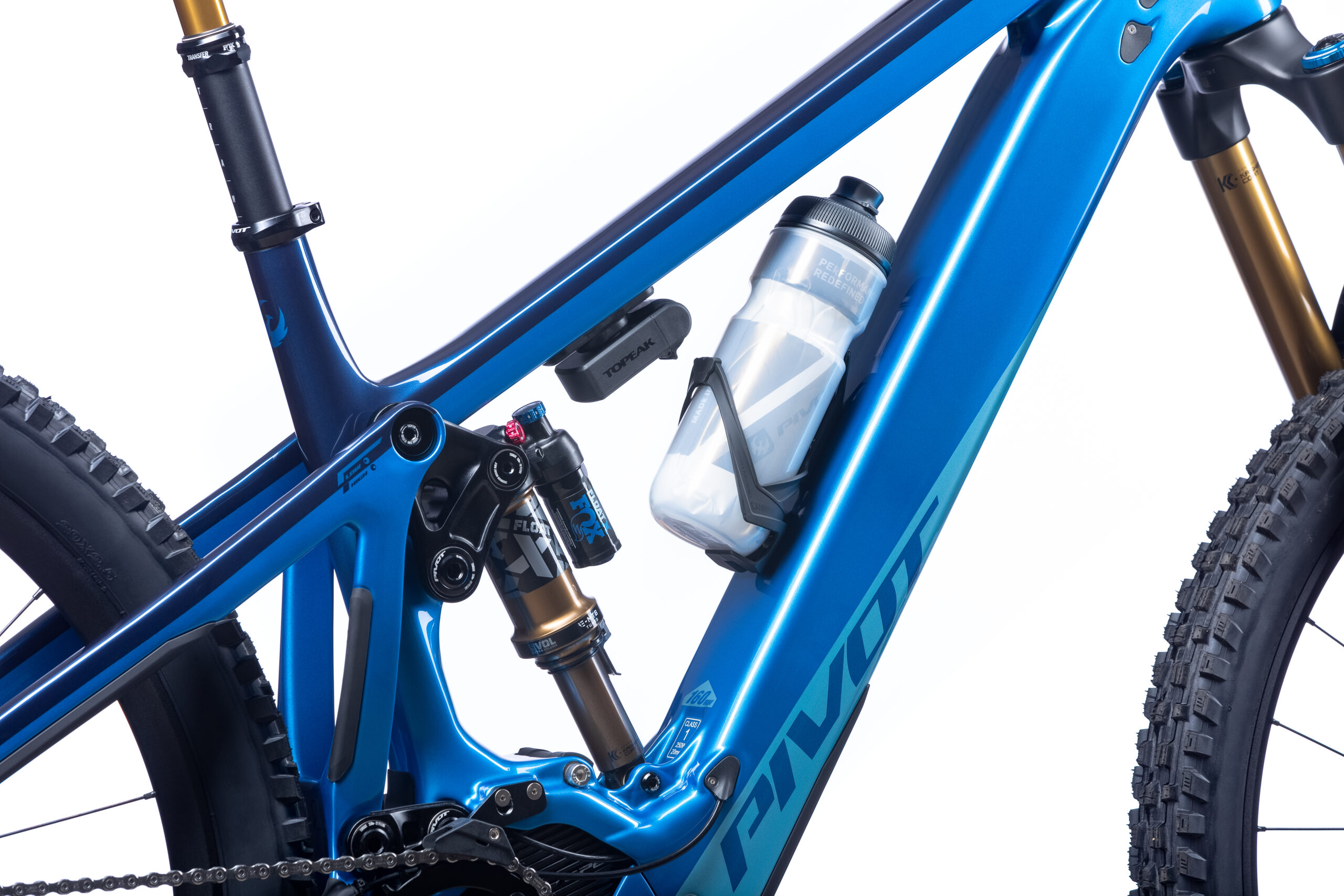
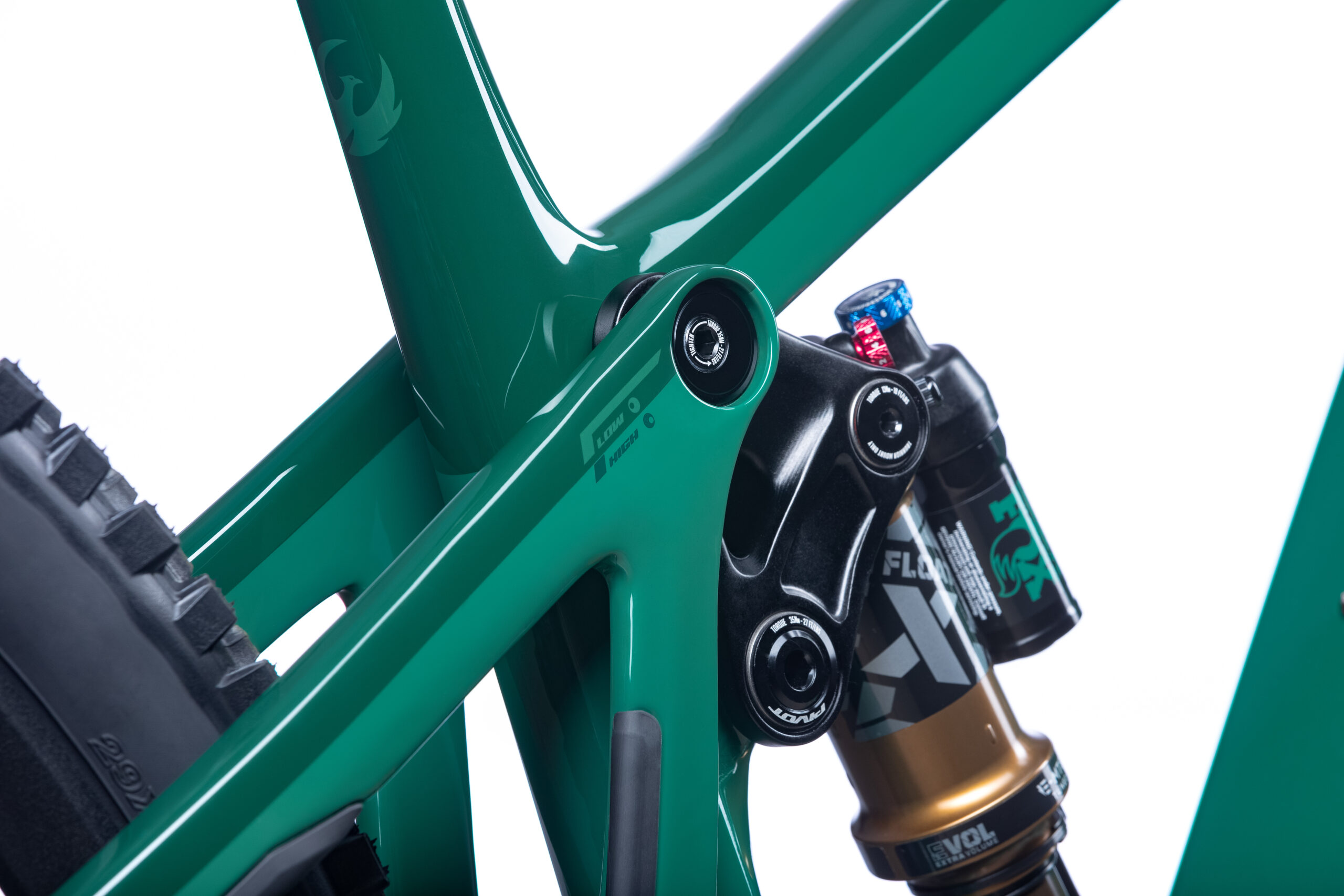
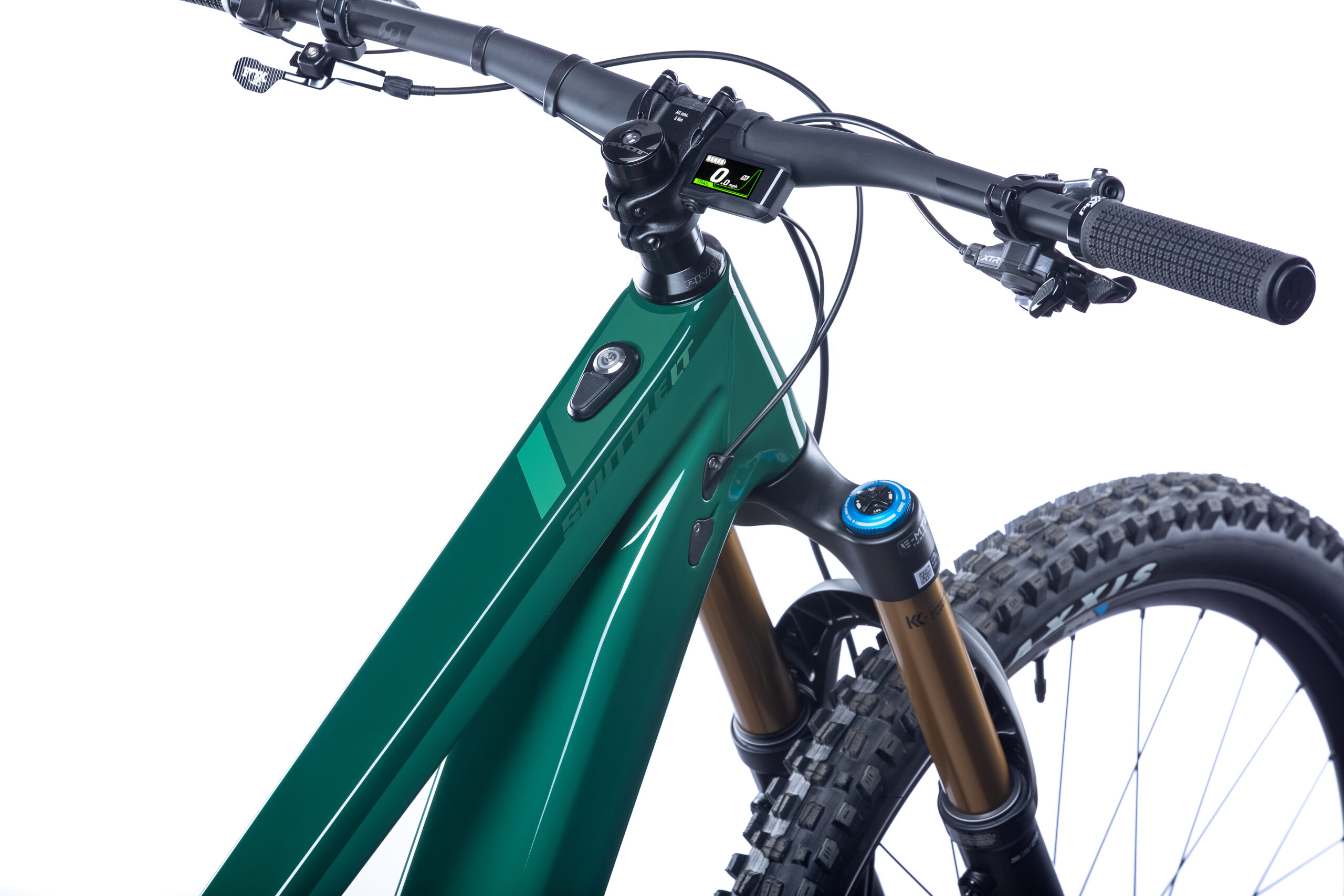
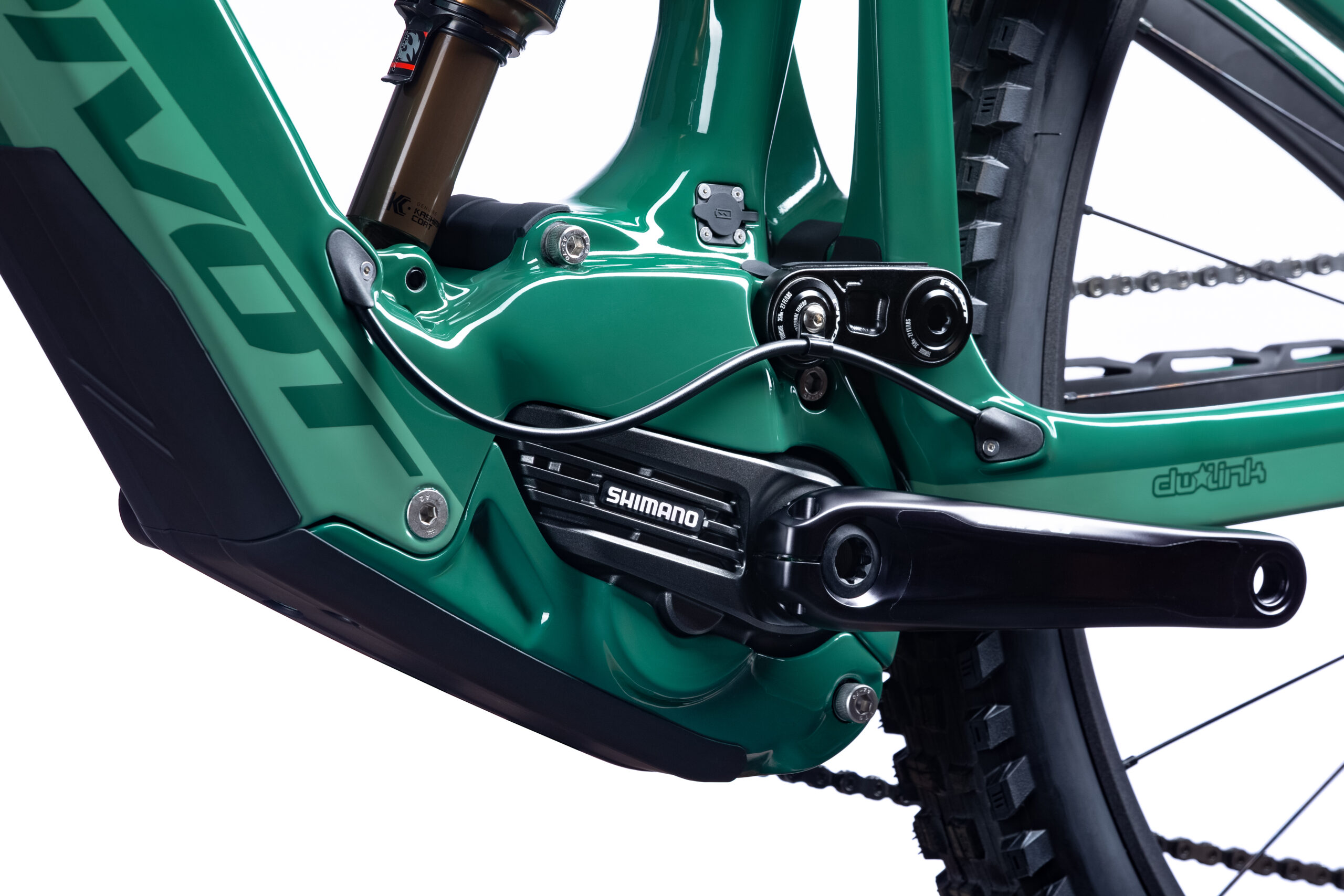
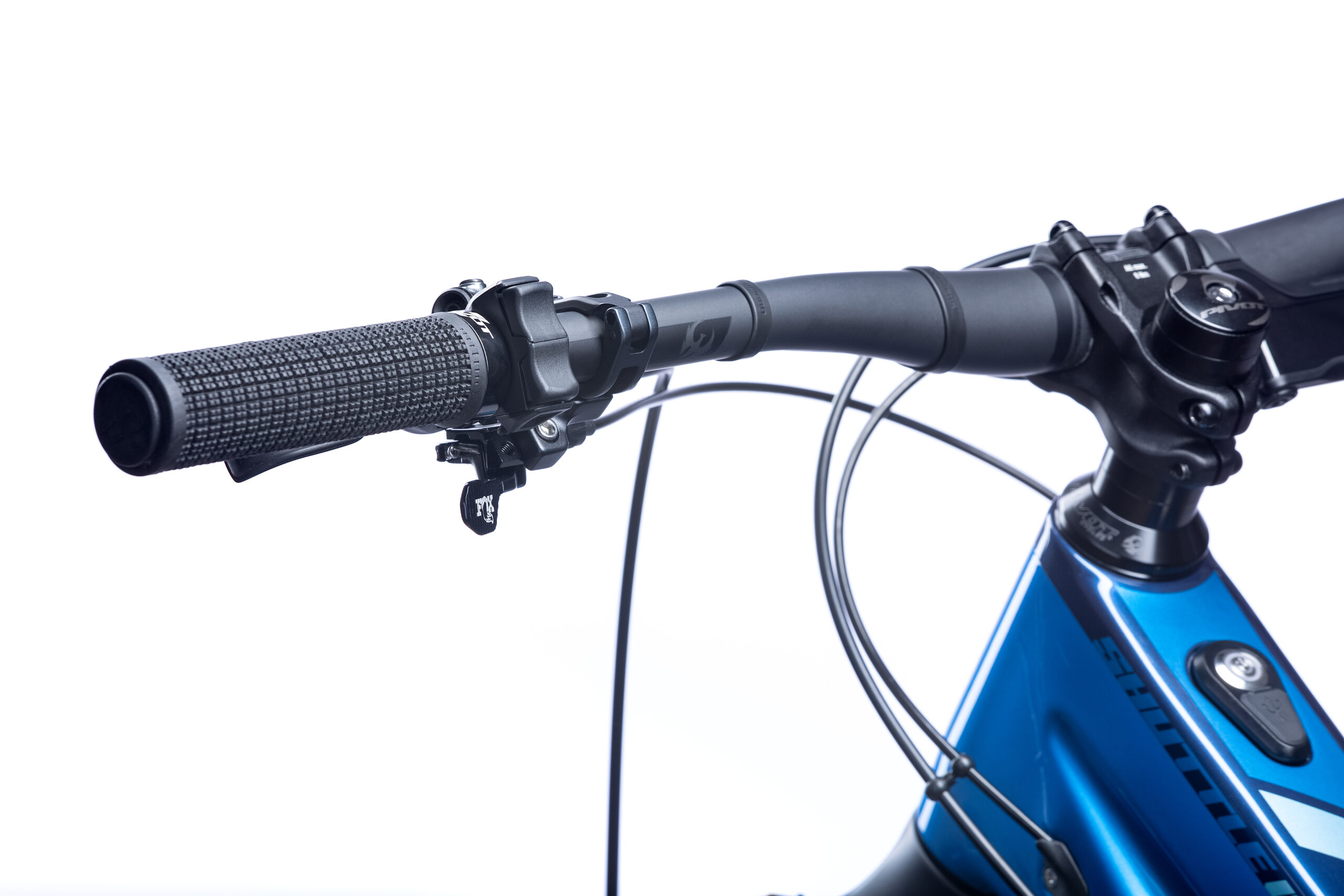
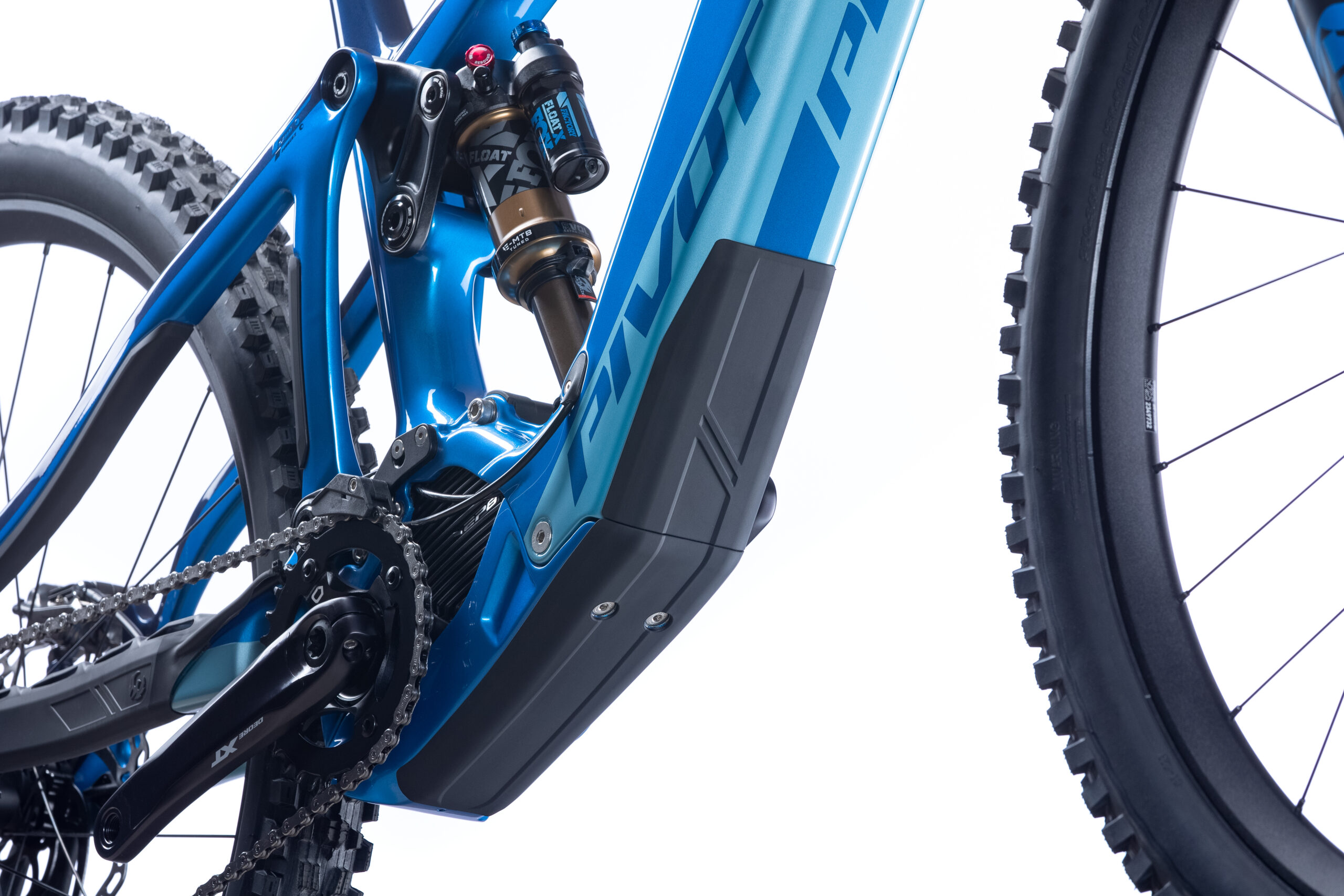
In contrast to the Shuttle SL, which uses a lightweight Fazua 60 drive unit, the Shuttle LT opts for a full-power Shimano EP8 setup, paired with a 756 Wh battery, stored internally in the downtube. Pivot says that the battery has been placed lower in the frame for both easier removal and a lower center of gravity, and it’s charged through a port just above the drive unit at the base of the seat tube. Pivot says that the whole package is good for six hours of ride time “if you can resist the temptation to run it in Boost mode all the time.”
The Shuttle LT uses the standard Shimano EP8 mode controller on the left-hand side of the handlebar, with the display mounted behind the handlebar; a power switch integrated into the top tube rounds out the controls.
The Shuttle LT uses a SRAM UDH derailleur hanger, and a brake mount for a 203 mm rotor without the need for an adapter. Pivot says that the Shuttle LT can be used with a coil shock (in a 205 x 65 mm trunnion size) and that forks up to 180 mm of travel can be used; dual-crown compatibility is out.
Fit & Geometry
Pivot offers the Shuttle LT in sizes Small through XL, which they say covers riders from 5’3’’ to “6’1’’ +” (160 cm and up). The sizing on the XL looks fairly typical of the fit for a modern XL Enduro bike (which is to say, pretty big), but of course, there are going to be limits on that “6’1’’+” sizing without an even larger size in the range.
Pivot mentions that they drew heavily from the Firebird (full review coming next week) in designing the Shuttle LT, and while their geometry isn’t 100% identical, there are a whole lot of similarities. The headtube angle is 64° on both bikes, and they share the same reach numbers (445 to 510 mm, in roughly 20 mm increments), similar seat tube angles (about 77°, varies slightly by size), and so on. The stack height on the Shuttle LT is notably higher, by around 20 mm in a given size, and the Shuttle LT forgoes the variable length chainstays of the Firebird in favor of 441 mm ones across the board (making them longer than the Firebird in all sizes apart from the XL).
Those numbers are all stated in the “Low” geometry setting; switching to the “High” one steepens the angles by 0.5°, raises the bottom bracket (to 17 mm of drop, from 22 mm), and adds a few millimeters to the reach.
The Builds
Many of Pivot’s models get an extensive range of build options, but they’ve pared things down to just two on the Shuttle LT. Both get Fox 38 / Float X suspension packages, four-piston Shimano brakes with big Galfer rotors, and burly DT Swiss e-bike wheels. Both builds look quite nice, if not exactly cheap. It’s arguably surprising to see the Fox Float X rear shock instead of a Float X2, but I don’t think it’s a bad call; I would personally like to see burlier tires than the Exo+ MaxxTerra Maxxis Assegais that come on both ends, especially on an Enduro e-bike, but that’s an easy fix.
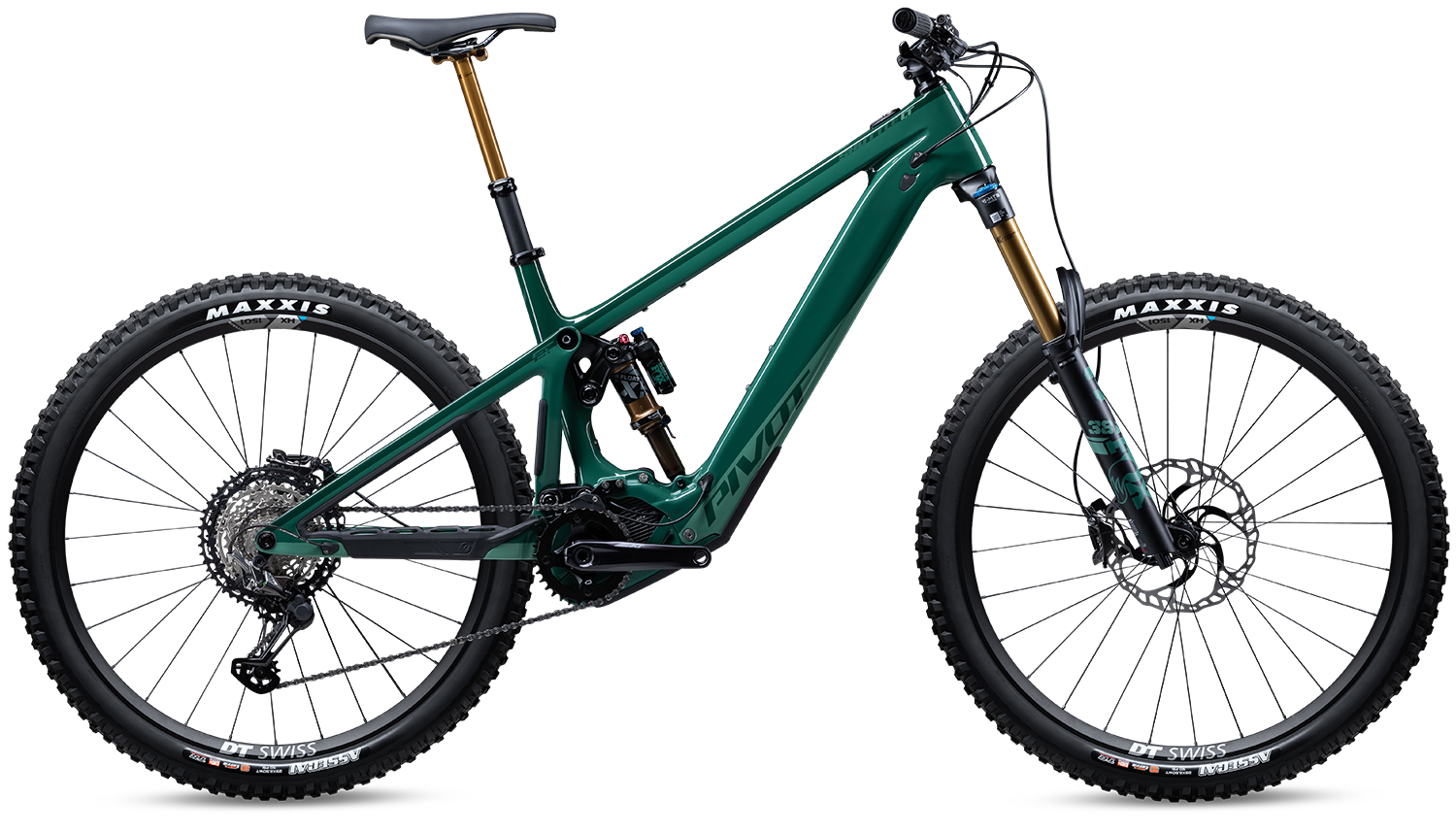
- Drivetrain: Shimano SLX w/ XT rear derailleur
- Brakes: Shimano SLX 4-piston w/ Galfer rotors (223 mm front / 203 mm rear)
- Fork: Fox 38 Performance E-MTB
- Shock: Fox Float X Performance
- Wheels: DT Swiss H1900
- Dropper Post: e*thirteen Vario (S/M: 150–180 mm; L/XL: 180–210 mm)
- Drivetrain: Shimano XTR
- Brakes: Shimano XTR 4-piston w/ Galfer rotors (223 mm front / 203 mm rear)
- Fork: Fox 38 Factory E-MTB
- Shock: Fox Float X Factory
- Wheels: DT Swiss HX1501
- Dropper Post: Fox Transfer Factory (S: 150mm; M/L: 175mm; XL: 200 mm)
FULL REVIEW
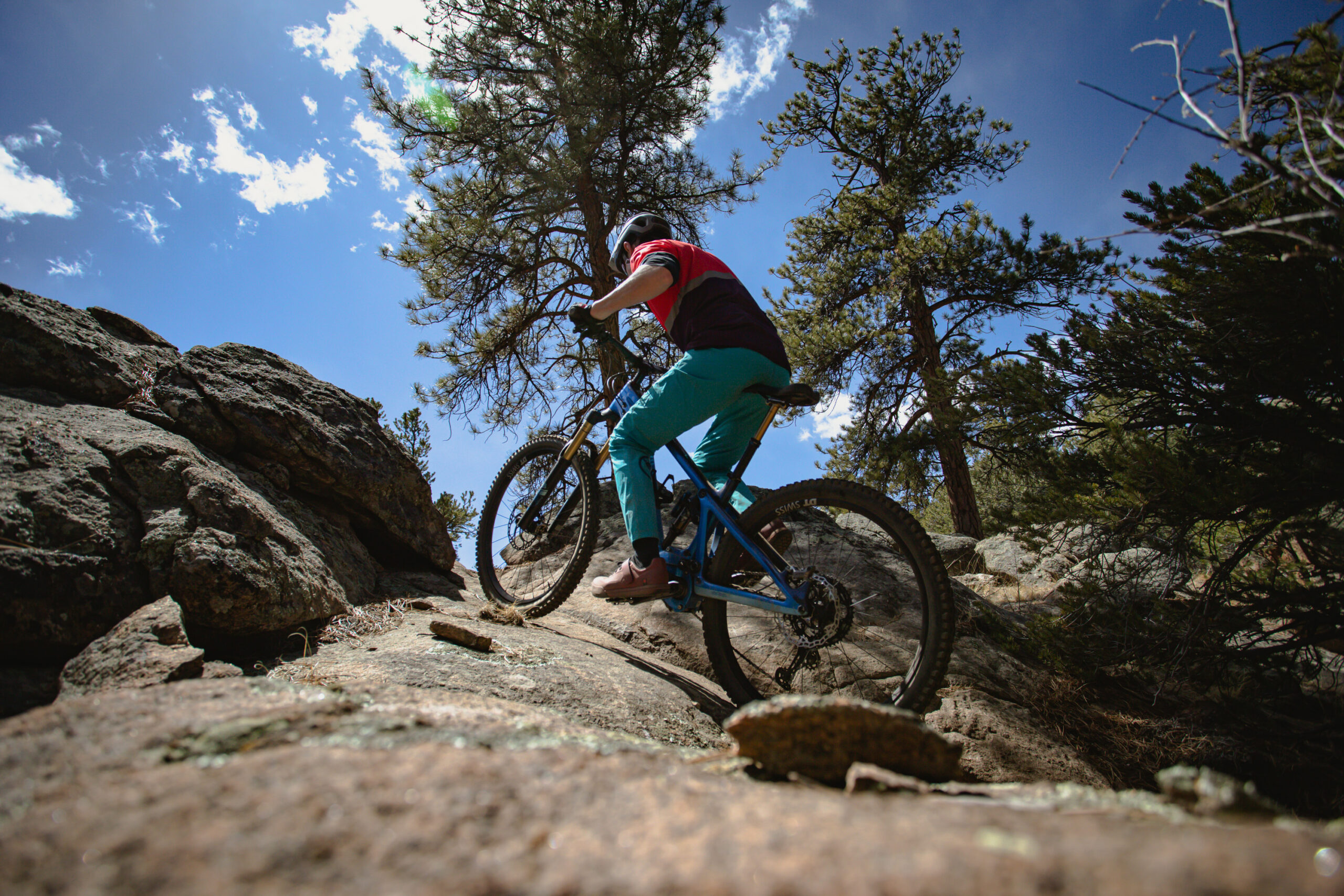
Intro
Simon Stewart (6′, 170 lbs / 183 cm, 77 kg): Drawing from the DNA of the very good Firebird — in Pivot’s own words, it’s a “‘Bird with bigger wings” — the Shuttle LT adds Shimano’s excellent EP8 drive system onto Pivot’s biggest Enduro bike. But while the Shuttle LT has mostly similar geometry numbers to the Firebird, there’s one figure that sticks out as being quite different, some differences in spec, and of course, the addition of a motor and batter. So is the Shuttle LT really an electrified Firebird, or does it feel like something rather different?
Fit & Sizing
One of the advantages of being 6’ (183 cm) tall is that I’ve rarely been in between sizes on most mountain bikes — I can’t think of a recent bike on which I’ve deviated from the size Large. Until the Shuttle LT came along.
Pivot has given the Shuttle LT proportions that have me on the brink between a Medium and a Large frame. Pivot’s recommended sizing puts me at the top end of the range for the Medium, and more in the middle of the Large range, but after quite a bit of sizing deliberation between Pivot and me — even bringing in Pivot founder Chris Cocalis for his thoughts — and based on my preferred reach and stack numbers, in conjunction with my riding style and the type of trails in my area, a Medium was chosen. The Shuttle LT isn’t a bike that everyone is going to be able to just snag in their typical size and go — ideally, there would be an opportunity to swing a leg over a couple of sizes to find out — but often that’s not a possibility, so let’s delve into how the geometry numbers and my riding style affected the decision.
The Shuttle LT has a geometry-adjusting flip chip, but we’ll be referring to the numbers in the Low setting as that is how the bike is shipped and also ended up being my preferred setting. First off, the reach on the Medium is 468 mm, and the Large comes in at 488 mm. With my preferred reach in the 475 mm range, the Medium is closer, and the 488 mm of the Large probably would’ve felt a bit long for me — easy enough. But it’s in the stack height where things get interesting. I absolutely love how Pivot has spec’d a higher-than-average stack across the size range (by as much as 20mm more than the Firebird in a given size). The Medium at 644 mm is more in line with what we often see for Large frames — and is in fact higher than many of them. I have found that I prefer a higher stack height on eMTBs since the extra height helps to control the added bike weight while descending, makes it easier to get the front end up, and generally feels more playful and fun in most situations. The benefits of keeping the bar height lower, like improved slow technical climbing, and weighting the front wheel in corners are mitigated by the higher climbing speeds of e-bikes and the added weight of the battery in the downtube.

Especially given the tall stack height — since I’d presumably be running fewer stem spacers and therefore shortening the effective reach less than I would be on a bike with a lower stack height — and because I tend to favor a playful, nimble feel over outright speed, I wound up opting for a Medium Shuttle LT, and haven’t second-guessed that decision in the slightest. I think a lot of riders who have always been a Large will find the Medium to be a good fit, though, of course, a test ride to verify is always ideal if possible.
Climbing
When distilling down the climbing performance of an eMTB, I think it goes without saying that there’s less of an emphasis on pedaling efficiency, but more on power delivery, technical aptitude, and composure. E-bike drive systems all have different characteristics when it comes to power delivery, but that’s only part of the equation — how the suspension and geometry manage that power delivery is paramount. It is here where the Shuttle LT really shines. In the geometry department, I’ve talked at length about the advantages of the higher stack height for eMTBs, and in relation to climbing, specifically steep weird stuff, I find the higher stack height to be an advantage. I know that goes against the grain of what we’re used to hearing, but bear with me here — in those really steep situations, I’ve found that a leaned forward standing position is the key, and the higher stack puts the handlebars in a more ergonomic position. It also “lightens” the front end, making controlled (timing the power assist to smoothly aid in getting the front wheel up) front wheel lifts easier — and power wheelies are addicting.
The suspension’s contributions to the Shuttle LT’s climbing prowess come in the way of seemingly unlimited traction (some of that credit goes to the Maxxis Assegai rear tire), and a nice balance of support and compliance. The Shuttle LT was rarely overwhelmed by a miss-timed technical ledge move (which often happens on an eMTB until you get the hang of it).
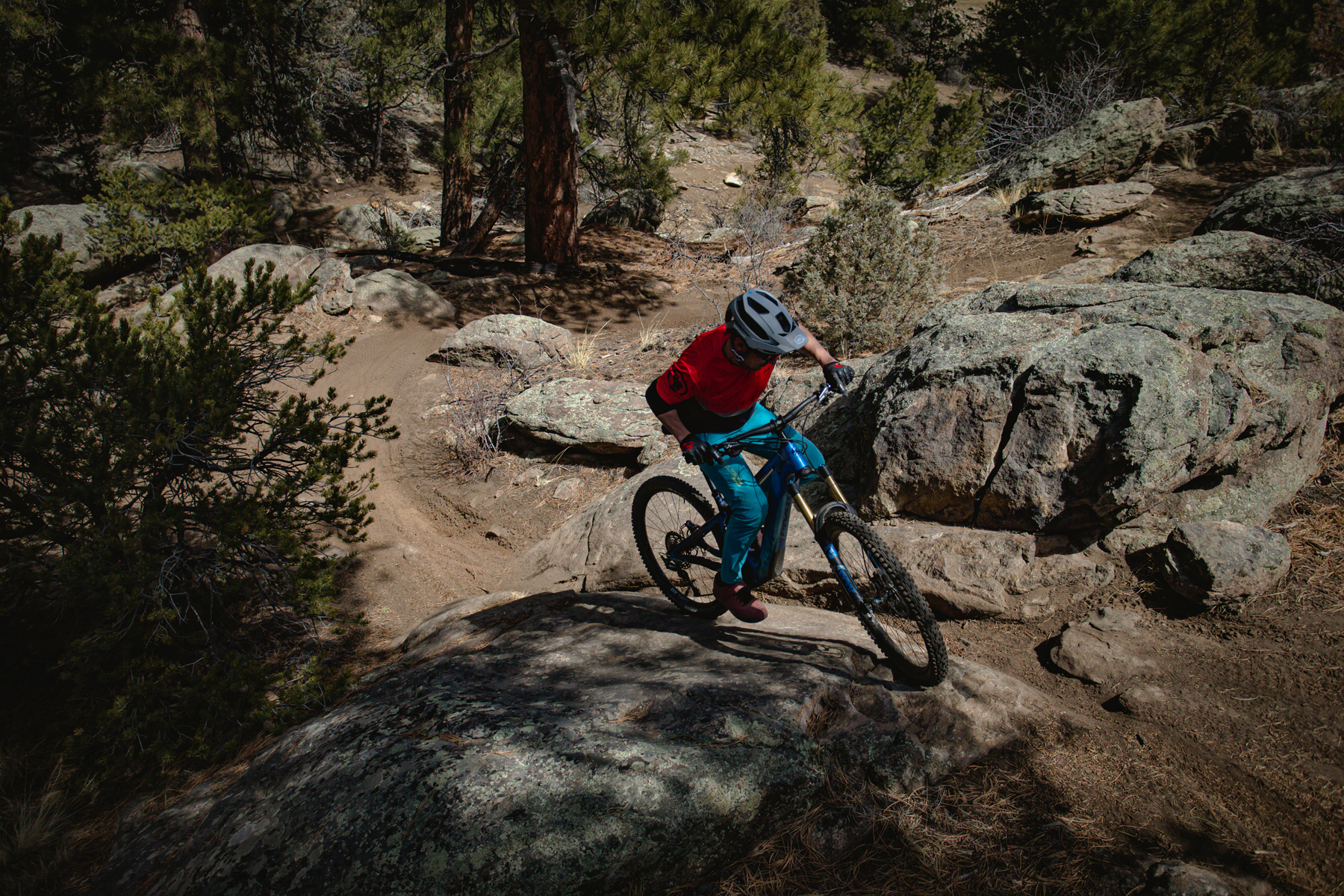
Despite my rocky, technical local trails, I preferred the Low geometry setting in most circumstances, so the majority of the miles have been in this setting. Clearance can be a concern when choosing a Low BB setting, but with only 22 mm of bottom bracket drop in the Low setting on the Shuttle, it’s decidedly on the higher side, and then throw in the 160 mm cranks and there’s all sorts of clearance for those big ledge moves — which are especially fun when you’ve got a motor.
In the Flash Review, I mentioned having some difficulty cleaning some of the extremely steep and tricky technical climbs (ones that are pretty much impossible on a regular mountain bike) that I use as a benchmark for eMTBs. I’m going to have to lay the blame on me for that, and my rusty early-season skills. The more time I got on it, and the further into the spring we’ve gotten, it has proven to be a non-issue whatsoever. I would say that now that the Shuttle LT has been excelling in these situations, and even has surpassed some of the high water marks achieved by other eMTBs I’ve been on — the Shuttle LT is an excellent technical climber.
Descending
This is where that Firebird DNA really shows up. The Shuttle just feels so composed, predictable, and effortlessly fast. There’s nothing about its downhill performance that left me wanting for more, I’m trying not to come across as gushing too much, but simply put, I love how this thing goes downhill. Overall it’s the combination of the well-thought-out parts spec (though at $11,999 complete for our Team XTR test bike it had better be good) — notably the unflappable Fox 38 out front, the strong Shimano XTR four-piston brakes, the Maxxis Assegais at both ends and that lovely rear suspension. I ended up going with slightly less than the recommended sag setting, and still routinely used all the available 160mm of travel, with still-excellent sensitivity. In regards to geometry, I again preferred the Low setting for descending, finding that it made the Shuttle LT a little more stable and composed, without being so low or slack as to become too much of a handful — and with 22 mm of bottom bracket drop and a 64° headtube angle, it’s hardly off the deep end on either metric.
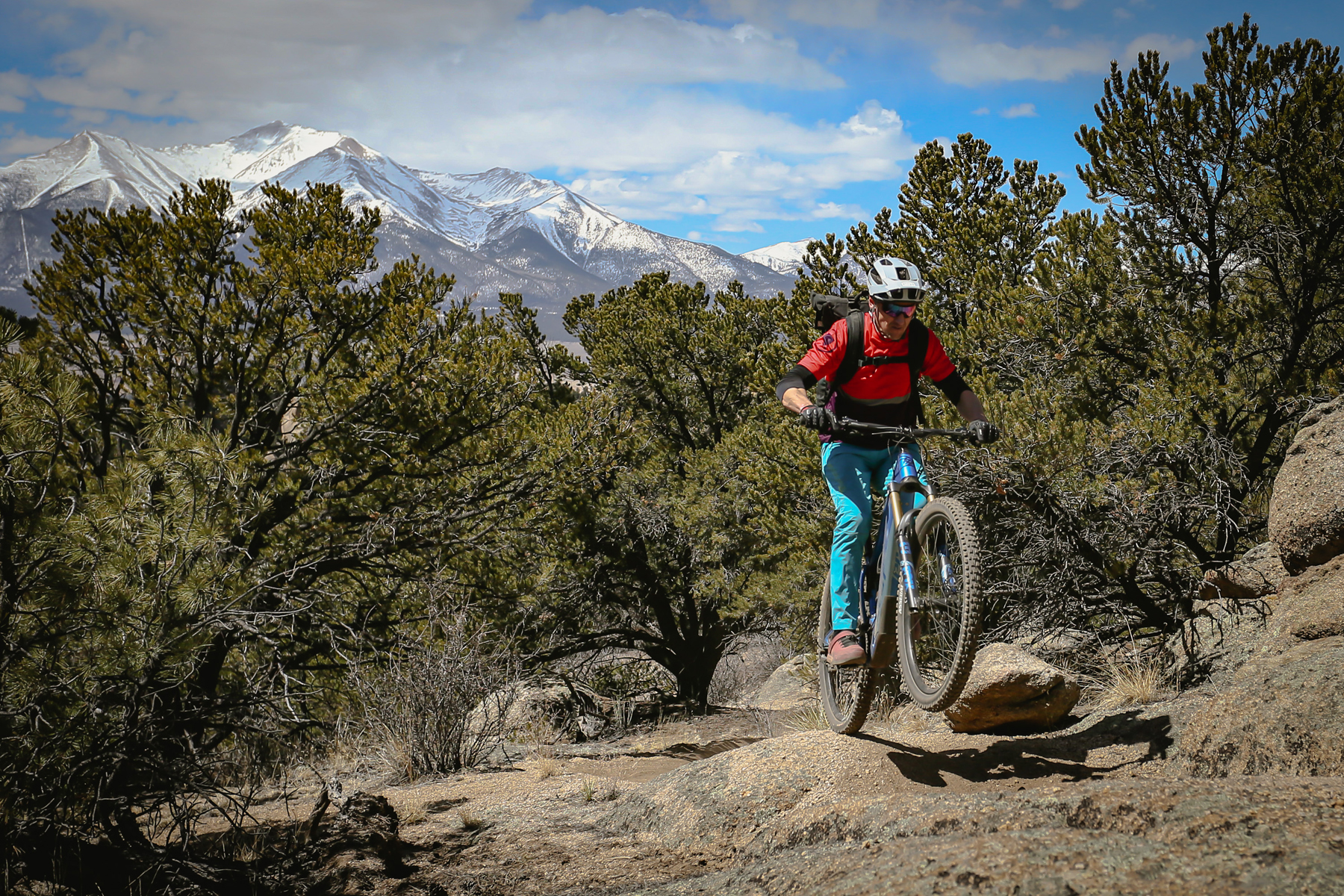
The high stack height puts the bars in a good position for an aggressive riding style, while also making it a bit easier to loft the front end and move the (heavy) bike around. It goes without saying that an eMTB takes more effort to get the front end up, so again I have to thank Pivot for the increased stack which makes that job easier. When compared to the Specialized Turbo Levo (full review coming soon), I would call it a little more business-like in the way it handles itself downhill; the Levo, on the other hand, has a slightly more playful personality, and in particular it’s easier to slash and drift the rear end of the Turbo Levo around. It’s a lot of fun, and while the Shuttle LT does corner well, it feels more purposeful and focused on going fast than the more playful Levo.
Overall, I prefer the suspension feel of the Shuttle LT. On paper, it has 10mm more travel but it ends up feeling like considerably more. The small bump sensitivity is excellent but the Shuttle LT still maintains good support and bottom out control when you need it — it’s definitely not ultra-plush at the expense of composure or anything like that — and there’s excellent traction available in most situations.
The Build
The build on our Team XTR review bike has been mostly solid, with the standouts being the Fox 38 Factory fork, Fox Float X Factory shock, DT Swiss HX1501 e-bike wheels, and the Shimano XTR 4 piston brakes with the beefy Galfer rotors. The only notable issue has been the Fox Transfer seatpost — at first it seemed to have an aversion to the cold and was sticking mid-way through its travel on the return. Now that the weather has warmed up, the problem unfortunately is still there, and it’s not the first Transfer we’ve had that has exhibited these symptoms — which of course is a warranty issue, and thankfully Fox has been traditionally very good at managing warranty repairs.
I’d also like to see a longer travel dropper post spec’d as well. Granted, I sized down to the Medium frame and am at the higher end of the sizing range for that bike, but there’s a ton of post exposed on the stock 175 mm Transfer, and the Large frame comes with a 175 mm post as well. I would venture to say that this would more than likely be remedied by the dealer, but it would be nice to see an option for a longer travel post, especially for those like me who have sized down.
David, who wrote up the First Look, and I tend to disagree a bit on tire spec. His preference would have been for tires with burlier casings than the EXO+ ones spec’d, like Double Down or even Downhill casings. I like the EXO+ choice because I’m going to install tire inserts anyway and that keeps the weight down. I don’t envy bike companies here as it’s impossible to make everyone happy with tire spec, but at least they are a wear item, and you can always replace them with your own preference when the time comes.
[David: I’m not really advocating for Pivot to spec DH casings on a bike like the Shuttle LT (though there’s a good chance I’d put one at least on the rear if I owned one). But mostly, Simon’s right that there’s no one right choice for everybody and it’s impossible to please everyone no matter what you spec on a given bike.]
When drawing comparisons to the Firebird, and as stated in the First Look, it is interesting that Pivot chose to spec a Fox Float X over the X2. With the extra mass of the Shuttle to manage, the X2 does seem to be the more logical choice. But the Float X has been excellent. It hasn’t felt overwhelmed or under-gunned, and the damping has remained consistent on long descents. I never wished the Shuttle LT had a Float X2 — actually quite the opposite, as I find myself regularly preferring the Float X over the X2 now, and when you consider the ease of servicing of the Float X in relation to the X2 (we’re talking about the ability to just do an air can service on Float X without a damper service, which you can’t do on the X2), then my vote goes to the Float X.
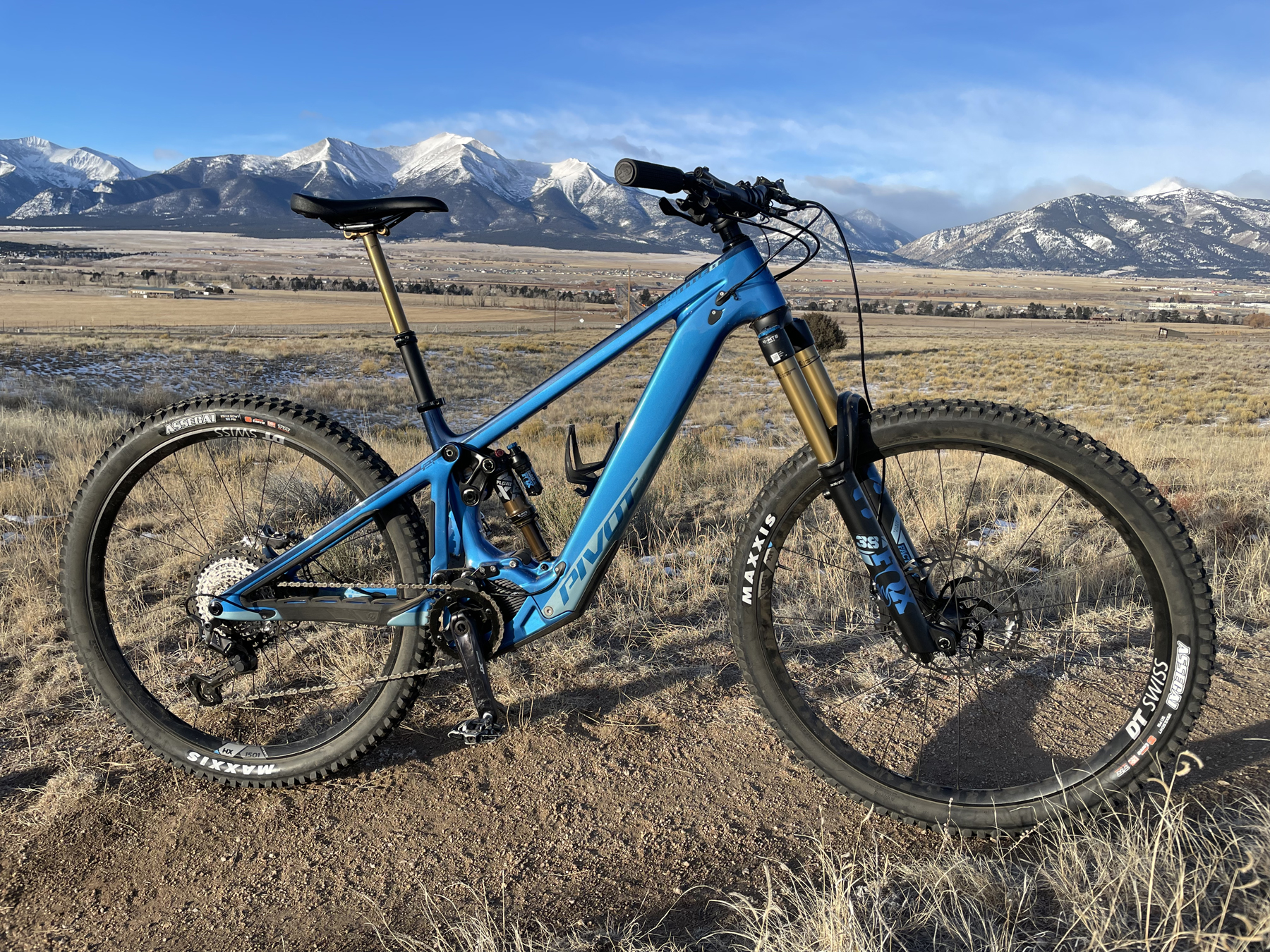
I’ll also take one quick minute here to mention the rear derailleur mishap I had. While riding a fairly spicy moto trail, I just barely clipped an exposed stump at downhill speed, and the carbon fiber cage on the rear derailleur essentially exploded — broken pulley wheels and all. Now, this is not the first time I’ve seen an XTR 12 spd derailleur come apart like that, and I can’t fault Pivot for spec’ing it on a top-tier build, but I can’t help thinking that lightweight parts like this XTR derailleur are a bit unnecessary on an e-bike. I know from experience that an XT with an alloy cage would absolutely still have been damaged by the impact that exploded the carbon cage on the XTR, but there’s a solid chance it could have been bent back into usable alignment. The XTR was destroyed so the bike had to be single-speeded to ride out, which on a bike with this much travel is a tricky maneuver.
Drive and Range
E-bike range is a hot topic, and I think it can be easy to get hyper-focused on the numbers such as battery size and motor power, but that would be missing the big picture. The reality is the Shuttle LT has the capability to go farther and last longer than most will ever need. It’s also very difficult to quantify and compare range with any consistency as so many factors influence it, and I think hours of ride time are a better indicator of range than mileage. From my testing, the Shuttle LT went about 3.5 hours on boost mode (highest power setting) in varied terrain, and I was getting 5 hours out of it using a combination of assist levels on my bigger test loop. For reference, the elevation gain is about 2100 ft on my 3.5-hour test loop and was right at 4000 ft on the 5-hour one. Both loops are solid days on the bike no matter which way you look at it. I have been running the Levo back to back with the Shuttle and have found that the range on both is very close, even though the Levo has a smaller 700 Wh battery.
Unlike some of its competitors, Shimano open sources its battery technology that works in conjunction with its drive systems. What that means in layman’s terms is that companies like Pivot are free to design their own batteries, which allows for better integration into the frame, and also how big of a battery to integrate. The Shuttle LT’s battery is 756 Wh, which, while not the biggest out there (I think that distinction goes to Canyon and Norco for now), is plenty big. The drawback to bigger batteries is of course more weight, and where that weight is positioned affects the handling. Keeping the weight low is beneficial, which is another advantage to the flexibility that Shimano allows, as it gives companies more options in terms of dimensions and placement. One last thing on batteries, the Shuttle LT’s battery is one of the bigger ones out there and has an impressive range to show for it, and it’s the biggest one I’ve tested so far. I’m not convinced going bigger will have an advantage though, as it’s a fine line between size and starting to sacrifice handling as a result. I’ll have a better sense of this after I get on some 900 Wh bikes, but as it stands now, as I’ve ridden many bikes with smaller batteries, I can say I believe Pivot has struck a nice balance of range, weight, and handling.
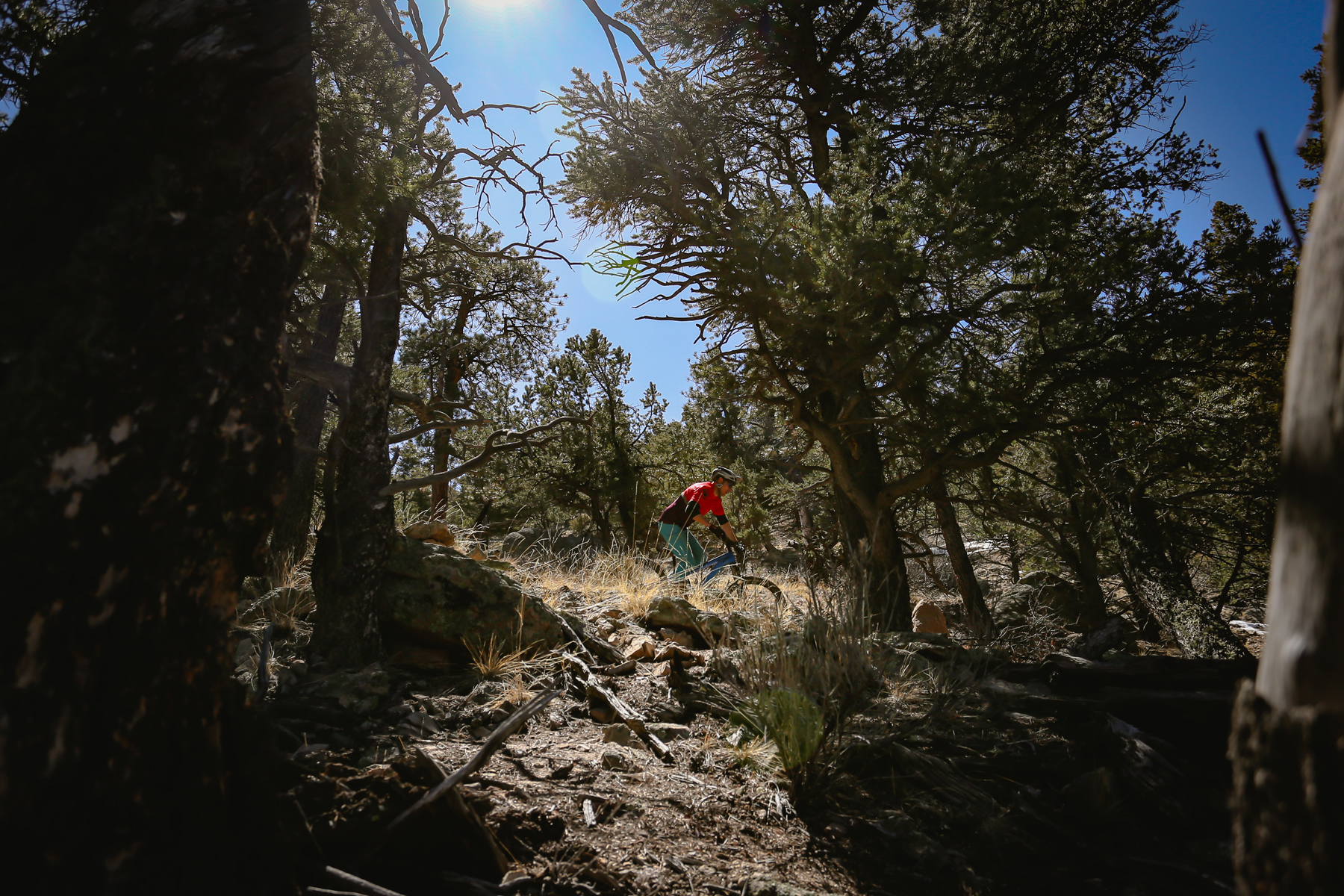
Who’s It For?
As tends to be the case with full-power, big-battery eMTBs, the Shuttle LT is for riders who want a long-range, powerful bike. What distinguishes the Pivot from the competition is the exemplary suspension performance and high-speed stability and composure. It’s for folks who want what feels like an electrified Enduro race bike, and it’s a very good one.
Bottom Line
The Shuttle LT is a very impressive take on a full-power, long-travel eMTB. There were a few minor hiccups — mostly the sticky seatpost — but I’ve come away very, very impressed by the Shuttle LT. Given its geometry tweaks and so on, the Shuttle LT isn’t exactly an electrified Firebird but instead feels like a very coherently designed take on a bike that’s meant to have similar design goals, just in a motorized package. Pivot hasn’t just slapped a motor and a battery on the Firebird and called it a day, and the Shuttle LT is better for it.

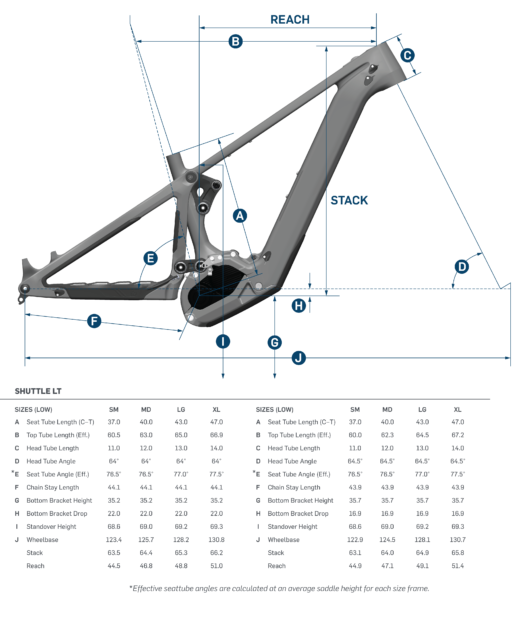
so blister doing press release now?!?
Awesome review! Nice work Simon.
Let me know the next time you are in Buena Vista, I’d love to show you around! Shout out to Buena Vista Singletrack for all the hard work!
Love my LT Team. Beastly machine and more nimble than one would expect for a “big” bike. It shreds.